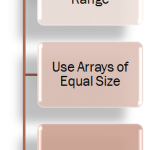 In my experience, most of the people who I train have never heard of – let alone use – Array Formulas and Functions in Excel. However, once I demonstrate how they work, they become “hooked” and want to learn more about these “Magic Formulas!” In this tutorial, I demonstrate, “step-by-step” how to use the FREQUENCY() Function in Excel.
In my experience, most of the people who I train have never heard of – let alone use – Array Formulas and Functions in Excel. However, once I demonstrate how they work, they become “hooked” and want to learn more about these “Magic Formulas!” In this tutorial, I demonstrate, “step-by-step” how to use the FREQUENCY() Function in Excel.
Previous Tutorial on The Company Rocks Website
If you watched my previous tutorial, I used the same data set and a Pivot Table to Group these 500 plus Sample Records by Age Bracket. Using a Pivot Table, you can quickly “group” ages into brackets – without writing a single formula! However, on the down side, you must use a consistent “step-value” for these groupings – in this case by 10 years. When you need more flexibility in organizing your Age Brackets, use the Frequency Function in Excel.
How to Use the FREQUENCY() Function in Excel
- Create your “Bin Array.” In this example, enter – in ascending order – the ages that you want to find the “frequency of occurrences” between
- Select the “Array of Cells” that will contain your FREQUENCY() Function results.
- Write the FREQUENCY() Function – 1st argument is the “Data_array”. In this case, I created a Named Cell Range called “Age.” this is mu “Best Practice Tip!”
- The 2nd argument is the “Bin_array.” Choose the vertical range of cells that you created in step 1 of this list. Make sure that the “size” of this Array matches the “size” of your Array Formula Selection.
- Complete the Array Function with the keyboard combination of “Ctrl + Shift + Enter.” This “CSE” combination is essential when entering all Array Formulas and Functions!
My Secure Shopping Website
I invite you to visit my secure shopping website – http://shop.thecompanyrocks.com – where you can preview all of the training resources that I offer. If you want to learn more about formulas and function, I offer a great resource: “The 50 Best Tips for Excel 2007.” Regardless of the version of Excel that you are currently using, you will pick up many great tips to improve your Excel skills!
Watch Tutorial in High Definition
Follow this link to watch this Excel Tutorial in High Definition on my YouTube Channel – DannyRocksExcels.
View My Tutorial Now on YouTube



